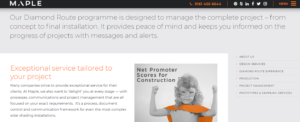Customer satisfaction is important to all businesses to enable them to grow. But there’s lots of other reasons too, referrals being one of them.
Where do you get your referral business from?
You know when you’re out networking and you get asked where you get most of your business? In the past I answered that question by listing the different types of sources: intermediaries like accountants, customers, outbound or inbound marketing, etc. I didn’t offer any analysis of the quality and quantity of the leads from those sources. Mainly because I didn’t have that data to hand, and why give away my ‘market intelligence’. So where do I really get my referral business from?
Customers, of course…
I’m not holding onto some big secret. The best sources of leads are my customers – the people who have experienced me. Naturally, the work I do with my customers is fairly personal, it involves two-way trust, understanding, sharing of confidences.
Of course my work involves lots of rational analysis, number-work and process understanding. But trust and loyalty come from that personal emotional stuff. When a business owner is open about their issues and aspirations, they are being vulnerable. That takes bravery and knowing that I am their trusted advisor.
Customer Relationships
I have known and worked with Jonathan Hunter, the Managing Director of Traditional Stone and Slate Supplies, for over 7 years. We’ve been to each other’s house for coffee and discussions, been to rugby matches together. Jonathan has given my daughter a lift to school. We’ve been through the highs and lows of our businesses. So, I shouldn’t be surprised that Jonathan introduces me to his business contacts.
Building Trust
Most trust builds up in step-functions, in moments-that-matter, in our instantaneous reactions to what someone says or how they behave. Time-based trust is the kind of trust that depends on reliability, dependability, predictability – requiring repetition over time. The trust between Jonathan and me has built up by loads of small and large actions, discussions and promises kept.
Credibility
A more powerful form of trust is credibility, the sense that the other person is capable and competent – an expert. I have been advising Jonathan about his business for those 7 years. Strategic planning, listening to his options and clarifying his business decisions, or helping to recruit new staff.
Intimacy
Finally, there is intimacy, the sense that the other person understands us deeply, respects our innermost feelings, and is a safe haven for personal issues. This is the sense that the other party has our best interests at heart, rather than just being focused on themselves. Jonathan and I have had discussions about personal meaning, why we see the world as we do, what makes us tick. We know each other.
Customer Satisfaction Leads To Trust And Loyalty
So how does all this trust discussion link to customer satisfaction?
If you have customers who are fully satisfied with your product or service, they are likely to trust your business, and they are likely to be loyal to your business. They keep coming back to use your products or services. Just like Jonathan has kept working with me over the last 7 years. Equally, they are likely to recommend your business to their friends, just like Jonathan did last week.
So that trust and loyalty has a double whammy: repeat customers and new customers!
The Golden Nuggets Of Customer Satisfaction
Nugget 1: Measuring Customer Satisfaction
Now we’re getting to the nuggets of this blog. If you can measure that trust and loyalty (let’s call it customer satisfaction), then there are at least three more benefits:
- You have a measure of customer satisfaction that you can track over time to assess your improvement;
- You get feedback from customers on what you are doing well or need to improve;
- You have credible evidence to support your business valuation should you plan to sell your business. Remember, a buyer is buying your future business revenues, so a measure of customer loyalty gives more confidence about the future.
Here’s the first nugget: there is a simple proven measure of customer satisfaction. It’s called the Net Promoter Score (NPS) – devised by Fred Reichheld, Bain and Co. and Satmetrix (trade marked by all three).
If you are wondering how to calculate your NPS, here’s a brief explanation:
- Survey your customers to rate your service or product based on the question, ‘On a scale of 0 to 10, how likely are you to recommend XXXX to a friend or colleague?’;
- Those who score you 6 or less are termed detractors (less likely to promote you), 7 or 8 are called passives (somewhat likely to promote you) and most importantly, 9 or 10, are called promoters (highly likely to promote you);
- Your NPS is the % proportion of promoters less the % proportion of detractors – see the image below;
- The rating is supported by the answers to 2 supplementary questions, essentially 1) why did you give us your rating? 2) what could we do to get a higher score from you?
When I did my NPS survey I got 65. Getting above 50 is classed as excellent, about 70 is world class – I’m nearly there!
Some Startling Statistics
I spoke to Nigel Greenwood, a leading expert in customer experience, about NPS over a coffee at Blacker Hall Farm Café, our regular haunt. Nigel shared the following really startling statistics:
- Only 30% of UK businesses get any form of feedback from their customers;
- 10% use the feedback beyond marketing, i.e. doing real service improvement work;
- Only 5% go back to their customers to feedback the results of any changes or improvements to services as a result of the customer survey.
The great news from these figures is that you can join a minority of the best businesses by getting feedback from your customers. If you can progress through improvement work and telling your customers about it, then you are truly in with the best of the best.
Nigel’s alternative to the two supplementary NPS questions is to ask:
- What did we do well? So that we can do more of it;
- How could we do better? So, we know what poor things to do less of;
- What else could we do? So, getting ideas for new products or services.
Other top pieces of advice from Nigel on getting the most from your NPS activity:
- Your primary focus should be on moving the passive proportion towards promoters and stop them falling back to detractors;
- A secondary focus is moving the detractors towards passives. This would contribute to moving the proportions of bands towards promoters;
- Do your NPS surveys at least quarterly if not monthly. Then you can see the trends over time;
- Give yourself time to improve your NPS – improvement can take over a year to make a real impact;
- When going back to your customers with feedback on how you are improving your service, use the same communication channel as the original survey. Though you can of course create written or video feedback. Plus you could go public and share your feedback by a press release – then your survey work can be a lead generator.
- The best timing for doing an NPS survey is at a moment of truth. That isn’t always at the time the service or product was delivered. It could be several months later when the customer is in ‘business as usual’ mode and can give some realistic feedback on the value of the service of product. That’s also an ideal time to get a testimonial and case study. Also feedback at a moment of truth can help improve those moments of truth.
Nugget 2: The Higher Your NPS, The Higher Your Revenue Growth
Research by the founders of NPS have found that:
‘Firms with a higher NPS enjoy higher long term growth rates, whereas firms with lower NPS have lower long-term growth rates’
If you want to read more about the research findings, download the Satmetrix white paper, ‘The power behind a single number’.
Last year I came across a business called Maple Sunscreening – they make architectural facades. Look out for the façade on the John Lewis car park in Leeds – Maple did that. One thing that impressed me about Maple was that they are in the construction sector and use NPS to monitor and improve their customer service. The team at Maple believe NPS is supporting their business growth.
Time To Take Action?
So, you must be wondering what your NPS is? How do you rate against your industry peers? Just as I did an NPS survey for my business using my Value Builder software, I can help you do your survey. For more information book a call with me using this link
Also, you can reach out to Nigel Greenwood at his website or email address:
Book a call with me now to find out how I can help you to do your survey.


